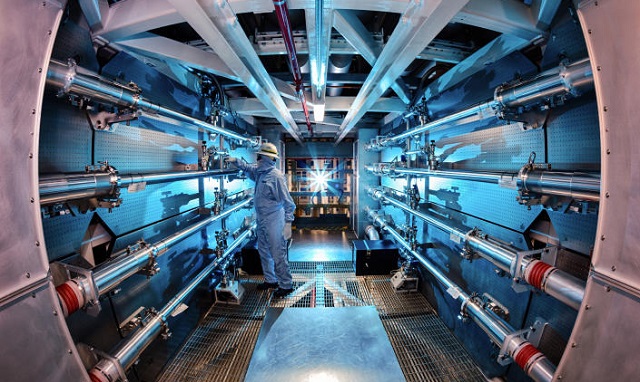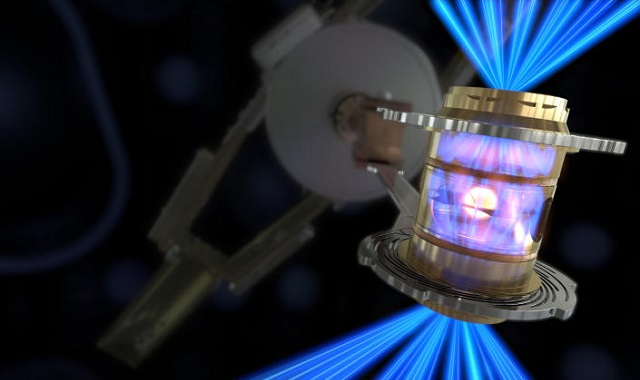
Fusion breakthrough draws energy gain
NEWS ANALYSIS | Agencies | U.S. scientists have achieved “ignition”- a fusion reaction that produced more energy than it took to create — a critical milestone for nuclear fusion and a step forward in the pursuit of a nearly limitless source of clean energy, Energy Department officials said on Dec.13.
Nuclear fusion, the process that powers the sun and other stars, occurs when two atoms’ nuclei collide under extreme temperatures, causing a reaction that can generate incredible amounts of energy with few environmental costs.
Scientists have been chasing the promise of fusion since the dawn of the atomic age, but had yet to cross a threshold in which more energy was created by a fusion reaction than the energy needed to produce it.
To exceed that milestone, researchers at the Lawrence Livermore National Laboratory’s National Ignition Facility fired the energy of 192 laser beams at a cylindrical target called a hohlraum, creating x-ray radiation. The radiation imploded a tiny, diamond capsule filled with two isotopes of hydrogen, deuterium and tritium, releasing energy.
“We have taken the first tentative steps toward a clean energy source,” said Jill Hruby, the Energy Department’s National Nuclear Security Administration.
The breakthrough will not immediately open the floodgates to clean power in American homes, but it is a powerful symbol that the fundamental scientific concepts underlying the promise of fusion are sound.
“There are a lot of scientists who said, ‘I don’t believe any of you guys. You’ll never make it work,’” said Stephen Bodner, a former director of the laser fusion program at the U.S. Naval Research Laboratory, or NRL. “Livermore showed — lo and behold — you can do it.”
U.S. Secretary of Energy Jennifer Granholm described the breakthrough as “one of the most impressive scientific feats of the 21st century.”
Engineering challenges remain that could take years or decades to work out before the technology could fuel power plants and transfer energy to the U.S. electrical grid, experts say.
While the Livermore team achieved what researchers call a scientific break-even or energy gain, it did not achieve an engineering break-even: The inefficient lasers used in the experiment required about 300 megajoules of energy to fire just 2 megajoules of energy into the experiment. The reaction produced about 3 megajoules of energy.
The reaction started and finished in about as long as it takes to blink your eyes and temperatures were roughly ten times hotter than the temperature of the sun, Livermore scientists said in a news conference.
Scientists must now find ways to reduce inefficiencies, burn a larger portion of available fuel during the reaction and harness the energy for use as electricity, said Troy Carter, a professor in UCLA’s department of physics and astronomy and the director of the Plasma Science and Technology Institute.
“The laser technology at NIF is ‘90s technology,” he said. NIF’s lasers can perform only a few shots each day. A power plant would require about 10 shots per second. Researchers would also have to figure out how to mass produce perfect capsules.
“Now that we have a capsule that ignites, we need to figure out: can we make it simpler? Can we begin to make this process easier and more repeatable? Can we begin to do it more than one time of day?” said Kim Budil, the director of the Lawrence Livermore National Laboratory. “Each of these is an incredible scientific and engineering challenge for us.”
The National Ignition Facility program is not designed to make energy for electricity; instead, it’s part of the “stockpile stewardship” program for U.S. nuclear weapons, which allows scientists to verify their reliability without detonation.
It’s unlikely the next big advances will come out of the NIF laboratory, experts say.
“The NIF facility is doing world-leading research, but it was never designed to generate electricity; it’s not a power plant,” said R. David Edelman, the chief policy and global affairs officer for TAE Technologies, a California-based fusion company.
Instead, advances could come from other federal laboratories or from the private sector, where investors are seeding billions into a smattering of fusion projects.

Some projects use similar technology to what NIF has demonstrated; others are pursuing a technology that uses magnets to confine plasma at extreme temperatures to force fusion reactions.
Fusion companies reported more than $4.7 billion in total private investment commitments through the end of the year, according to the Fusion Industry Association. Fusion projects could see a boost in federal funding in the U.S., too. The Inflation Reduction Act provided millions in new funding for fusion projects and the White House this year convened the first fusion summit and developed a 10-year plan to commercialise fusion technology.
Bodner said he’s always been cautious with predictions about nuclear fusion in the past, but became convinced in the last few years that a fusion program could succeed if the federal government shifted its focus from weaponry to energy production.
“I think well within a decade, a well-run program would either succeed or fail. The technology is ready to go. What’s mainly needed is the money,” he said, adding the next step would be to build a more efficient, high-powered laser.
With fusion, there is no risk of a nuclear meltdown and it produces only helium as waste. Fusion reactors use relatively little fuel and cannot be used for nuclear warfare.
The core materials — deuterium and tritium — are theoretically plentiful. Deuterium is abundant and can be extracted from water, Carter said. Tritium can be extracted from lithium, which is also in ocean water.
“Hundreds of thousands to millions of years of fuel for all energy we need on earth is in seawater,” Carter said.
If scientists can work out more of the problems that have dogged fusion for seven decades, it would be a reliable source of power to work in concert with wind and solar power to boost the clean energy movement.
“You can deploy it anywhere and it can be always available,” Carter said. “If we deploy it in time, I think it could fill a lot of the energy needs of the future.”
Researchers view it as a complement for wind and solar power, which are scaling up quickly and falling in cost but remain dependent on particular weather conditions and are difficult to store with today’s technology.
From a cost perspective, “I don’t think you’ll ever compete with wind and solar. They just sit there and turn out energy, there’s nothing simpler than that,” Bodner said.
Paul Dabbar, the former undersecretary of energy for science until 2021, compared the process of scaling the experimental reaction at a lab into a commercially viable source of electricity to the evolution of electric vehicles over the past several decades.
“It takes a while, but it’s doable,” said Dabbar, now a visiting fellow at Columbia University’s Center on Global Energy Policy. “What we did 15 years ago has now turned into whole new industries. So the prospect of this not in two years, but in 10 to 15 years, similar to what happened with EVs and lithium-ion is absolutely possible.”
Dabbar predicted that developing the experimental process into commercial power plants would require additional “hard science” from the federally supported National Laboratories as well as major universities that conduct fusion research, plus start-ups and private-sector companies with experience in building power plants.
As humans seek ways to power modern life without harming the planet, Dabbar said it was fitting that the “ultimate source” of clean energy would be the one we see every day in the sky: The sun, whose process of nuclear fusion scientists have spent decades trying to recreate.
“Nature decided that fusing hydrogen atoms was the most efficient way to make energy. The universe is populated primarily with hydrogen,” Dabbar said. “So nature’s already made its decision on what’s best.”
*****
This article was originally published on NBCNews.com
 The Independent Uganda: You get the Truth we Pay the Price
The Independent Uganda: You get the Truth we Pay the Price



Hello everyone, it’s my first visit at this web page, and article is
truly fruitful designed for me, keep up posting such content.
I read this post fully on the topic of the difference of hottest and preceding technologies, it’s remarkable article.
You can full the sportsbook registration procedure in West Virginia in a matter of minutes.